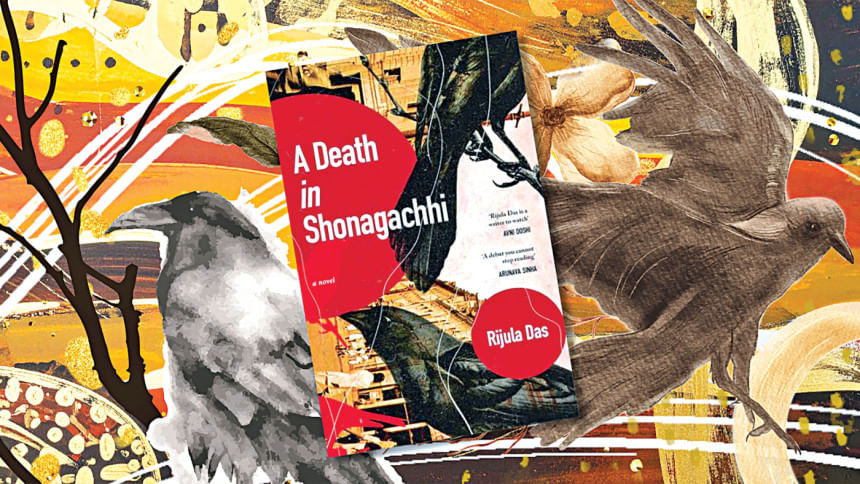No heroes in Shonagachhi

Don't mistake A Death in Shonagachhi for a murder mystery, or you'll be setting yourself up for disappointment. Some moments will remain unexplained, threads will refuse to tie neatly, and certain ends will stay frayed. Strictly speaking, Rijula Das's explosive debut can be classified as literary noir. More poetically, it is a soul-baring depiction of a community built in the most unexpected of places—a testament to resilience in the face of crushing blows, and a promise that love can overcome the agony of circumstances beyond one's control.
Tenderness is difficult to find in a neighbourhood like Shonagachhi, yet Das's words evoke a softness you'd be thoughtless to ignore. Asia's largest red-light district becomes unexpectedly homely—despite the gore and grit of the horrors that unfold. Her prose is both kind and unrestrained; it does not shy from pain, nor does it hide the agony waiting behind those walls. It is maddeningly honest and, at times, disastrously funny.
So you trust her—and her characters—as they descend into hell. It's bodies all the way down, with degradation and decay on every side. You might pray for the unfortunate, the wicked, or the dead, but it would do no good. God hides them far away. Das's characters are shaped by the impediments placed before their dignity, hope, and spirit—a damning indictment of society's careless treatment of its outcasts. This is ostracisation for ostracisation's sake.
The first person we meet is Tilu, though all eyes are on Lalee—the woman of Tilu's dreams and the source of his addiction. Lalee is the river in Tilu's bloodstream: thoughts of her ebb and flow without cease. Barely clinging to the lowest rungs of the caste system, Tilu is without charm and desperate for some. He is Lalee's most dependable customer, and lust's most dependable sinner. Lalee, meanwhile, seldom spares him a glance outside of business; she is the archetypal cynical, practical prostitute familiar from brothel portrayals in fiction. Other stock figures populate the novel: the cruel madam Shefali, the comically villainous zealot Maharaj, the greedy upstart pimp Rambo Maity, corrupt policemen who exploit the women they disdain, and frustrated social workers chasing leads that go nowhere.
Yet, despite these archetypes, moments of originality shine through—like when macho cop Samsher Singh shyly tells his terrified wife he would love to have a daughter, despite his mother's protests. Or when the number one fan of Tilu's explicit works joins him in a high-stakes chase to rescue the woman he loves, knowing nothing about her. Or when the indifferent Sonia, prized for her exotic looks, comes to Lalee's aid in her darkest hour. These small moments coalesce into a portrait of community, starkly contrasted by the "small deaths" that slowly erode it.
The first major shock is the brutal, graphic murder of Lalee's neighbour, Mohamaya—known as Maya—an "A-lister" in The Blue Lotus hierarchy. What is less shocking is the response: the police do not visit the scene until ten days later. Singh, the examining officer, arrives to find the room scrubbed clean and already occupied by another sex worker. Maya's death propels the plot, driving Lalee to take her place, and leading the reader into what will become her own grave. The story meanders through Tilu's plans for a novel, Singh's domestic life, and everyone's rage at demonetisation. These tangents can frustrate, especially as the most compelling figure—Lalee—is often sidelined.
None of the events in the novel would occur without the underlying degradation of safety for women and girls, particularly in rural areas. In forgotten corners of the Indian subcontinent live countless innocents, sold to settle debts, to feed fewer mouths, or to quench a father's drunken thirst. They are thrust into the hands of unforgiving madams, chained to bedposts, forced into the arms of violent men, and trapped in a system that refuses to acknowledge them. As Samsher Singh observes: "It's not for nothing that they put them in one corner, in these floating towns where they can remain among their own folk and not be a part of 'normal' life."
A Death in Shonagachhi builds to an excruciating crescendo that ultimately rings hollow. There is no resolution, no solution to the world's oldest problem: how do you protect the innocent? Whether that emptiness is deliberate or not, it forces the reader to confront the blindness with which society treats sex workers. More enduring, however, is the lesson tucked within its winding paragraphs: friendship among the forgotten, the camaraderie of laughing at one's woes, the comfort of knowing that "once loved is always loved." Even in a world that tries to swallow you whole, you can carve out your own place—and, if you dare, swallow the world right back.
Sejal Rahman is a contributor. Reach her at [email protected].

 For all latest news, follow The Daily Star's Google News channel.
For all latest news, follow The Daily Star's Google News channel. 



Comments